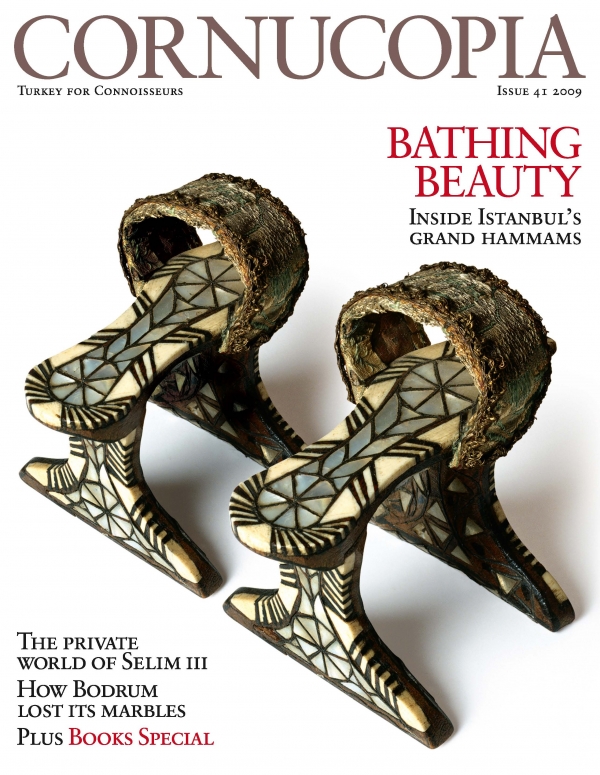Buy or gift a stand-alone digital subscription and get unlimited access to dozens of back issues for just £18.99 / $18.99 a year.
Please register at www.exacteditions.com/digital/cornucopia with your subscriber account number or contact subscriptions@cornucopia.net
Buy a digital subscription Go to the Digital EditionWith her discoveries at Cnidus she was the first female archaeologist to become a household name. But Aphrodite was the undoing of Iris Love. New York portrait by Jürgen Frank
At the very tip of the Reşadiye peninsula, almost at the line where the Aegean becomes the Mediterranean, lies the Ancient city of Cnidus (Knidos). It is now ruined and deserted but in ancient times it was at the centre of the world, on trade routes from Alexandria to Athens, and a shelter from the prevailing northwesterly winds. Bleached by the sun, scorched by the wind, surrounded by the turquoise sea, it is a harsh, sometimes bleak, but at the same time an intensely romantic, site. The moles and walls of the trireme harbour still stand. Fragments of column and cornice are scattered amongst the rocks and dark-green, wind-sculpted bushes of the maquis. In spring the ground is a carpet of wild flowers amongst shards of ancient earthenware.
High above the site, looking east to Kos, south to Nisyros, west to Rhodes and Symi, is the stepped base of a circular temple. Its discovery, made in July 1969, and announced to a stunned annual conference of the American Institute of Archaeologists in San Francisco in the last days of that year, briefly became world news. It propelled a young archaeologist, Iris Cornelia Love, to the kind of fame very few archaeologists achieve. She believed she had found the site of the temple that once housed Praxiteles’ statue of Venus Aphrodite, perhaps the most famous statue of the ancient world and one of Pliny’s Seven Wonders. If her thesis was correct, this was one the greatest archaeological coups of the century.
It is no exaggeration to say that for a short time, and while still in her thirties, Iris Love became the most famous archaeologist in the world and the first and only female household name in archaeology. The discovery appeared sensational, but it was the glamorous archaeologist herself – tall, blonde, handsome, self-confident and a close relation of the Guggenheims to boot – that really caught the imagination of the world. Iris Love seemed a shaft of sunlight in a fusty, male-dominated world. She found herself on the front page of The New York Times (bronzed and in the skimpiest of minidresses), on prime-time national television being interviewed by Barbara Walters, and the subject of profiles in scores of other magazines and newspapers around the world. Tabloids ran headlines such as “Love Finds Temple of Love” and referred to her as “the mini-skirted archaeologist”.
Born into a family of much-travelled artists, Joseph Schranz made his name in Ottoman Istanbul on the eve of the Crimean War with finely detailed, atmospheric panoramas of the Bosphorus. Admired by the Palace and by a new breed of intrepid tourist, he even trained a generation of Turkish artists to observe nature. Yet Schranz’s life in Turkey is an almost total mystery and his known works are tantalisingly rare
The transformation of the Black Sea’s vast Kizilirmak Delta from lost cause to paradise regained is a miraculous reversal of fortunes. The ornithologist Emin Yoğurtcuoğlu recalls his early visits and introduces the dazzling birds of the delta, while the anthropologist Caterina Scaramelli pays homage to a way of life that can only benefit both man and nature. Photographs by Emin Yoğurtcuoğlu
Like many others, when I first visited the Kızılırmak Delta wetland conservation area, I felt as if I had personally just discovered it. It was the summer of 2012… Caterina Scaramelli on the Black Sea’s most precious delta
Time has stood still at the Kavafyan Konak, the oldest surviving mansion on the Bosphorus. Abandoned for 20 years in the village of Bebek, it is a rare example of the refinement and restraint of 18th-century Ottoman design. From a fresco of a formal garden – recalling the fashionable obsession with horticulture – to a trompel’oeil parasol rosette, original decorative details survive, decayed and faded but intact. Text and photographs by Burak Çetintaş
The photographer Mark Cator shares his vivid diary and images of a ride across ancient Phrygia
Prodigiously talented and duplicitous, Parvus Efendi was a larger-than-life writer, arms dealer, fixer and bon vivant. Norman Stone sizes up the grand capitalist who oiled the wheels of the Russian Revolution and ingratiated himself with the Young Turks
Beloved of birds and bees, prized by Ottoman sultans and Bourbon kings, pears are a particular joy eaten ripe from the tree. But cooking coaxes the flavour out of even those mass-market varieties grown for a long shelf life and ripened in cold storage






Cornucopia works in partnership with the digital publishing platform Exact Editions to offer individual and institutional subscribers unlimited access to a searchable archive of fascinating back issues and every newly published issue. The digital edition of Cornucopia is available cross-platform on web, iOS and Android and offers a comprehensive search function, allowing the title’s cultural content to be delved into at the touch of a button.
Digital Subscription: £18.99 / $18.99 (1 year)
Subscribe now